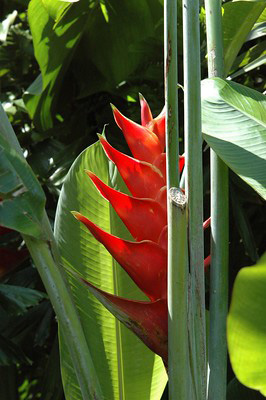Heliconia

Heliconias (hel-lick-KOE-nee-uhs) are true rainforest beauties. Gardeners love their lush foliage and bright, striking bracts. Ecologists, too, are fascinated by the plant’s link to rainforest birds.
Hailing from the tropical Americas and the Pacific, heliconia species are well-adapted for hot and steamy weather. These Florida-Friendly plants flourish in the warmer half of the state.
Characteristics
Heliconia species vary in size, color, and form but they are all tropical plants. Lacking cold-hardiness, heliconias are best suited for Zones 10B-11. Within this rage, the plants are usually evergreen.
Gardeners in Central Florida can add heliconia to the landscape, too. They will need frost protection, though, and may die back in cold weather. New shoots will sprout once it warms back up. And if your area is too cold for heliconia, you can enjoy a smaller species as a houseplant.
Produced in the spring and summer, the true flowers of heliconia are small. These tiny blooms are borne inside bracts on a long flower stalk. And while the flowers are hidden, the bracts are dazzling! They are waxy, long lasting, and make great cut flowers. One of the most popular species is lobster claw, Heliconia rostrata. Its flower stalk droops, dangling a string of scarlet and yellow bracts.
Heliconia leaves resemble bird-of-paradise and banana. They are huge, vivid green, and tropical. As a specimen or a mass planting they bring a coarse texture to a design. Species range from 1.5 feet to almost 15 feet tall at maturity. Most don’t grow above 3 feet but look up the species before you plant. Heliconia caribaea, for example, regularly reaches 10 to 15 feet.
Heliconias found in Florida landscapes are usually in the 5-6 foot range. We love lobster claw, but a few of our other favorites are a little less common. Heliconia psittacorum offers long-lasting color, and is a nice size for massing in landscapes. Heliconia champneiana produces a large, upright flower stalk with a dozen or more red to gold bracts. Heliconia nutans has a unique, dramatic flower structure, too.
Heliconias co-evolved with their rainforest pollinators, usually hummingbirds. Over time they became so specialized that each species attracts a specific pollinator. In its native range, hummingbirds visit heliconia daily to collect nectar. Many become territorial, protecting a few specific plants for their private feeding.
Planting and Care
Plant heliconia anytime the weather is warm but choose the site with care. They prefer a spot with partial sun or shade. Some heliconias, like lobster claw, can tolerate full sun. One non-negotiable is fertile, moist soil. If your soil is on the sandy side, till in some compost to the entire bed before you plant. Regular fertilizing during the growing season will keep heliconia looking its best.
Heliconia species grow quickly and some spread aggressively into nearby beds. If you prefer to keep them contained, plan ahead. You can install root barriers to keep the rhizomes from spreading. Some species do well as container plants, too. This is a good choice for low-maintenance and patio gardens.
Heliconias tolerate a variety of soil types and both acid and alkaline pH. They are only a little drought and salt tolerant, though. We do not suggest heliconia for dry or coastal landscapes. Most species are pest tolerant, but a few pests and diseases can be serious. We recommend regular scouting.
To propagate heliconia, divide the mass and plant the rhizomes in large sections. Within its range, these make excellent pass-along plants.
For more information about heliconia species contact your county Extension office.
